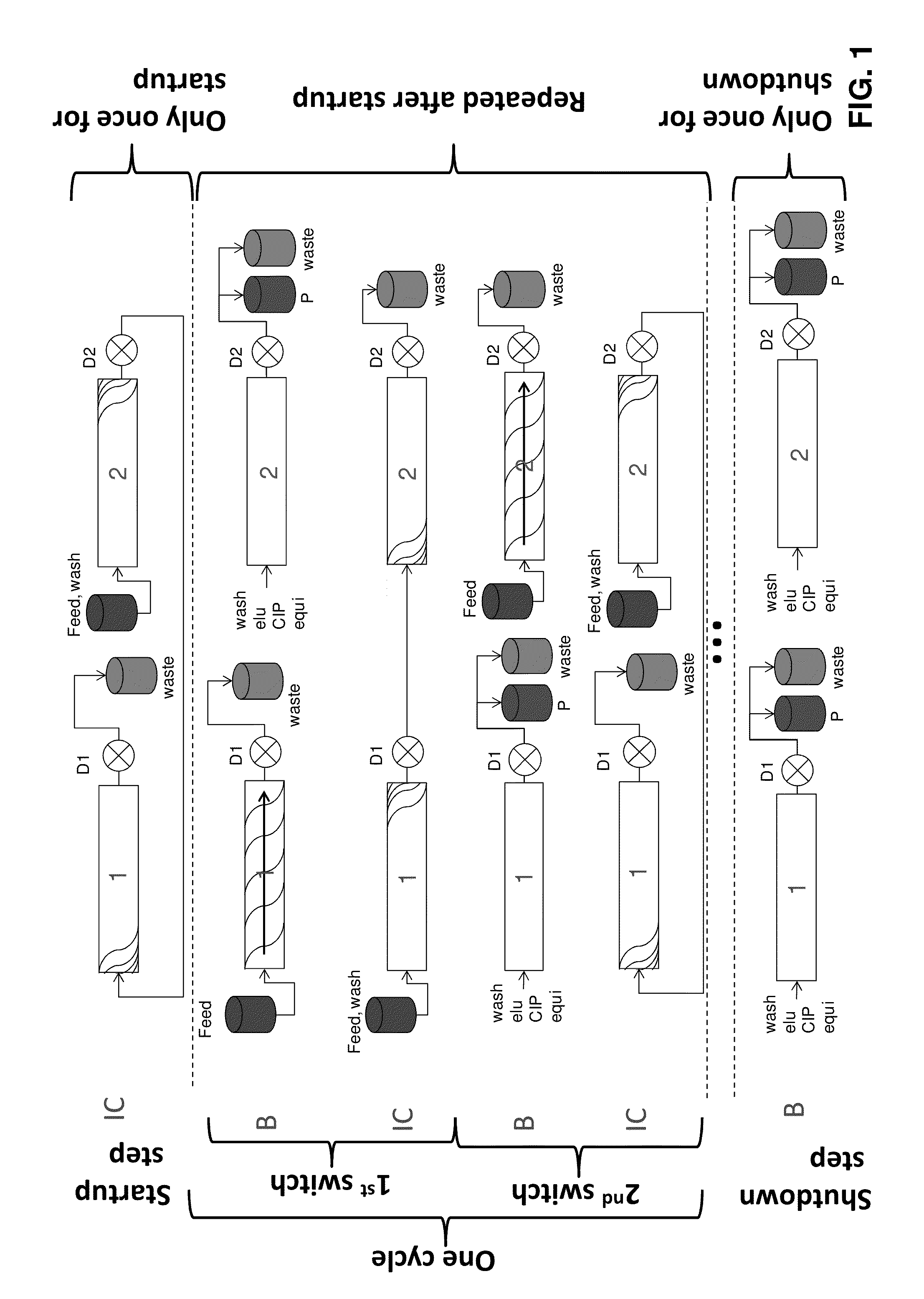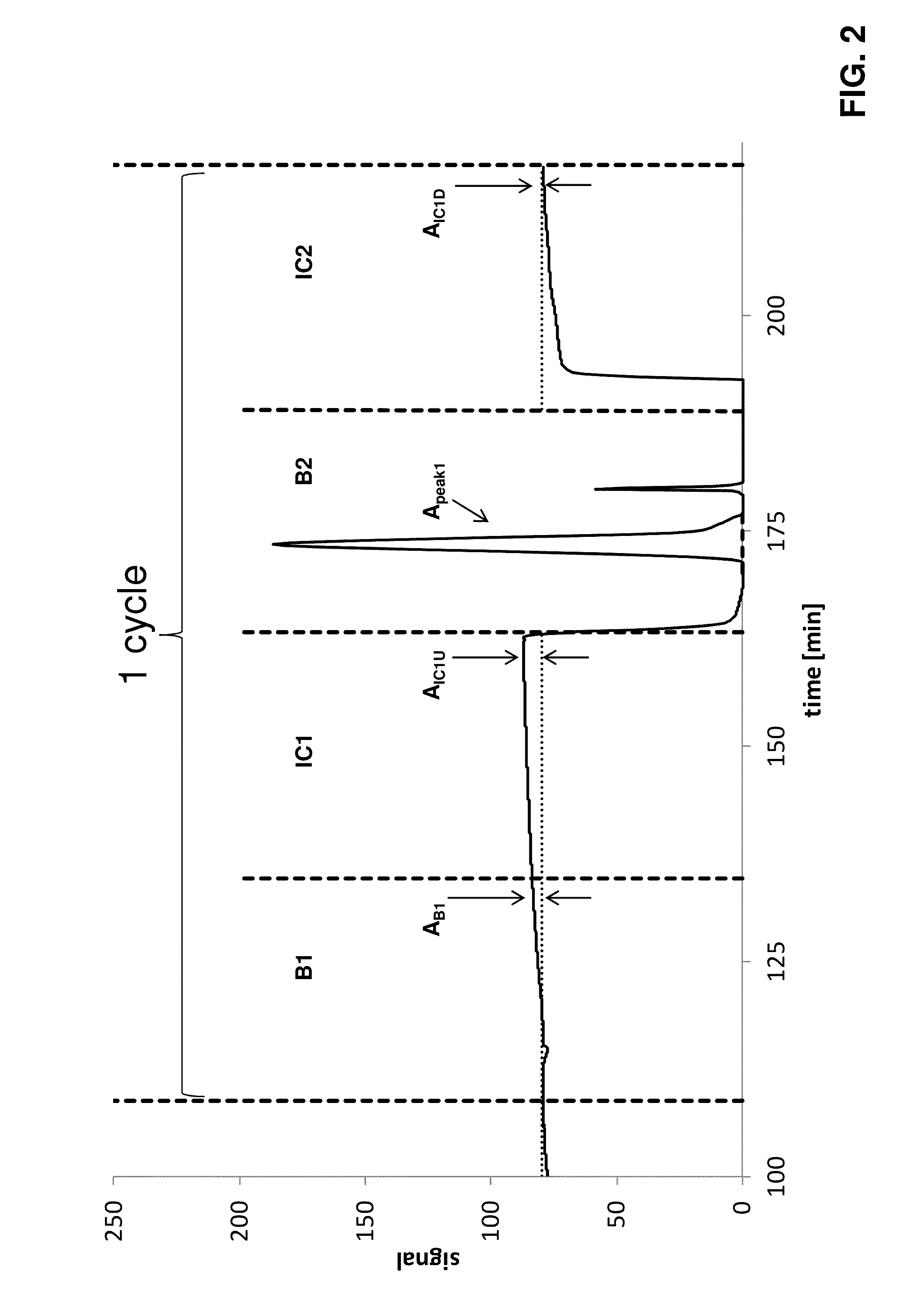Chromatographic purification method
a chromatographic and purification method technology, applied in the direction of ion-exchangers, separation processes, instruments, etc., can solve the problems of insufficient and efficient utilization of stationary phase capacity, early product breakthrough, and high cost of affinity materials
- Summary
- Abstract
- Description
- Claims
- Application Information
AI Technical Summary
Benefits of technology
Problems solved by technology
Method used
Image
Examples
example 1
Initial Determination of Operating Parameters for a Twin Column Countercurrent Sequential Loading Process
[0127]The initial operating parameters for a twin-column countercurrent sequential loading process for the purification of an IgG from clarified cell culture harvest using protein A affinity chromatography were determined based on the procedure outlined above. The breakthrough curves were recorded, fractionated and analyzed by offline Protein A analysis using a Poros A / 20 column (Life technologies, USA) to determine the IgG concentrations. The concentration of IgG in the feed was 1.0 g / L. The columns were of 0.5 cm inner diameter and 5.0 cm length. A protocol for the elution and regeneration of a loaded column was developed including a wash step of 6 min, an elution step of 7 min, a cleaning step of 6 min, a first equilibration step of 3 min, and a second equilibration step of 3 min; all at a flow rate of 1 mL / min Thus, the total duration of the elution and regeneration steps was...
example 2
Operation of a Twin Column Countercurrent Sequential Loading Process
[0130]A twin column countercurrent sequential loading process was used for the capture of an IgG monoclonal antibody from clarified cell culture harvest using a Protein A affinity stationary phase packed into two columns of 0.5 cm inner diameter and 5.0 cm length.
[0131]The process was operated with the following parameters on Contichrom Lab-10 equipment from ChromaCon AG, Switzerland. The UV detection wavelength was 305 nm. The process was run using the operating parameters determined in example 1, which are summarized in table 1.
TABLE 1Operating parameters for twin-column countercurrent sequential loadingprocess of example 2 including the startup phase. Qfeed indicatesthe feed flow rate, Qbuffer indicates the flow rate of all other steps;t is the duration of the substeps of the disconnected phase B and theinterconnected phase IC, respectively. The parameters for the final elutioncorrespond to the B parameters excep...
example 3
Detector Comparison, Low Impurity Signals
[0135]A twin column countercurrent sequential loading process was operated with the following parameters on Contichrom Lab-10 equipment from ChromaCon AG, Switzerland. Two detector cells giving different signals for the same sample were used for demonstration. The operating parameters are summarized in Table 3.
TABLE 3Operating parameters for twin-column countercurrent sequential loadingprocess of example 3. Qfeed indicates the feed flow rate, Qbufferindicates the flow rate of all other steps; t is the duration of the substepsof the disconnected phase B and the interconnected phase IC, respectively.The parameters for the final elution correspond to the B parameters exceptfor the feed flow rate, which is zero during the final elution step. The UVdetection wavelength was 300 nm.QbufferQfeedPhasestep[mL / buffer[mL / t[—][—]min][—]min][min]Bwash1.025 mM Phosphate, pH 7.00.26.0elute1.025 mM Citrate, pH 3.00.26.0clean1.00.1M NaOH0.27.0equilibrate1.025 ...
PUM
 Login to View More
Login to View More Abstract
Description
Claims
Application Information
 Login to View More
Login to View More - R&D
- Intellectual Property
- Life Sciences
- Materials
- Tech Scout
- Unparalleled Data Quality
- Higher Quality Content
- 60% Fewer Hallucinations
Browse by: Latest US Patents, China's latest patents, Technical Efficacy Thesaurus, Application Domain, Technology Topic, Popular Technical Reports.
© 2025 PatSnap. All rights reserved.Legal|Privacy policy|Modern Slavery Act Transparency Statement|Sitemap|About US| Contact US: help@patsnap.com



